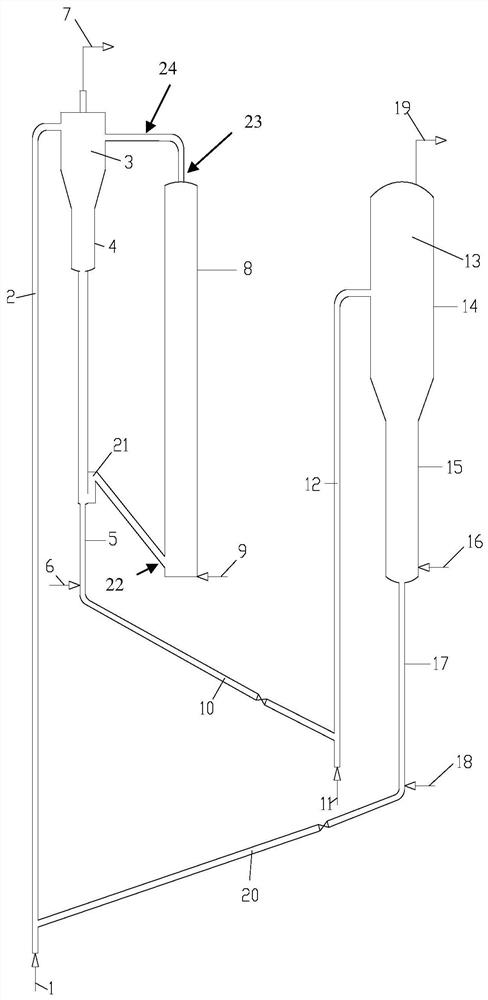A method for converting raw materials containing naphtha into light olefins and/or aromatics
A low-carbon olefin and naphtha technology, applied in the field of catalysis, can solve the problems of naphtha pyrolysis that cannot be ignored and high methane yield
- Summary
- Abstract
- Description
- Claims
- Application Information
AI Technical Summary
Problems solved by technology
Method used
Image
Examples
Embodiment 1
[0085] like figure 1 In the shown device, the catalyst is a microsphere containing naphtha catalytic cracking activity, the molecular sieve weight content in the catalyst is 30%, and the particle size range is 30-300 microns. Raw materials including naphtha enter the fast fluidized bed reactor through the feed port of the fast fluidized bed reactor to react with the catalyst, and the generated product enters the product gas outlet pipeline, and the catalyst enters the stripper. The inclined pipe and the riser enter the regenerator, and the regenerated catalyst enters the fast fluidized bed reactor through the stripping section of the regenerator and the regenerated inclined pipe. The product gas enters the separation system through the product gas outlet pipeline to obtain different products. Catalyst circulation is controlled by plug or slide valves. The composition of naphtha is shown in Table 1. Fast fluidized bed reactor conditions: reaction temperature 580°C, reaction ...
Embodiment 2
[0090] According to the conditions and steps described in Example 1, the catalyst is a microsphere containing naphtha catalytic cracking activity, the molecular sieve weight content in the catalyst is 10%, and the particle size range is 50-150 microns. Fast fluidized bed reactor conditions: reaction temperature 650°C, reaction pressure 0.1MPa by gauge pressure, gas phase linear velocity 5m / s, solvent-oil ratio 20. The product gas is analyzed by online chromatography, and the mass yield of olefins is 43%, the mass yield of aromatics is 20%, and the mass yield of methane is 7%.
Embodiment 3
[0092] According to the conditions and steps described in Example 1, the catalyst is a microsphere containing naphtha catalytic cracking activity, the molecular sieve weight content in the catalyst is 50%, and the particle size range is 50-150 microns. Fast fluidized bed reactor conditions: reaction temperature 690°C, reaction pressure 0.2MPa in gauge pressure, gas phase linear velocity 10m / s, solvent-oil ratio 80. The product gas is analyzed by online chromatography, and the mass yield of olefins is 46%, the mass yield of aromatics is 15%, and the mass yield of methane is 8%.
PUM
| Property | Measurement | Unit |
|---|---|---|
| diameter | aaaaa | aaaaa |
| diameter | aaaaa | aaaaa |
| particle diameter | aaaaa | aaaaa |
Abstract
Description
Claims
Application Information
 Login to View More
Login to View More - R&D
- Intellectual Property
- Life Sciences
- Materials
- Tech Scout
- Unparalleled Data Quality
- Higher Quality Content
- 60% Fewer Hallucinations
Browse by: Latest US Patents, China's latest patents, Technical Efficacy Thesaurus, Application Domain, Technology Topic, Popular Technical Reports.
© 2025 PatSnap. All rights reserved.Legal|Privacy policy|Modern Slavery Act Transparency Statement|Sitemap|About US| Contact US: help@patsnap.com



